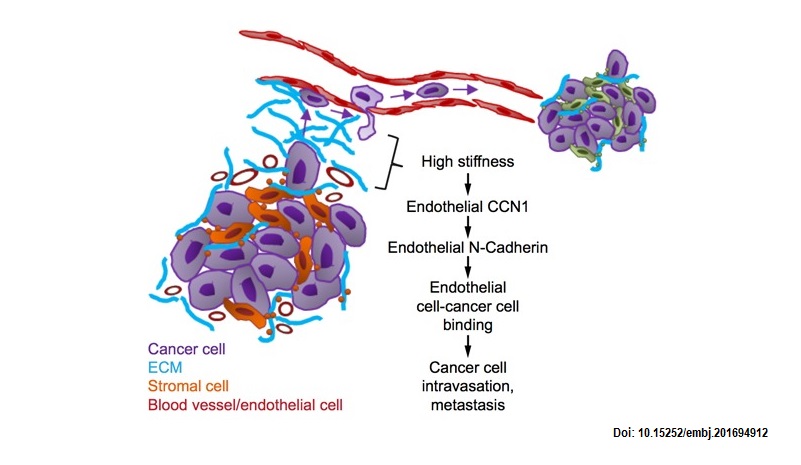
The link between cell-cell adhesion and tumour progression
- Post by: Zara Feroz
- February 28, 2021
- No Comment
Cell adhesion is the binding of a cell to another cell. Cell adhesion can be homophilic or heterophilic. Homophilic adhesion is when the cell adhesion is caused by binding of similar adhesion molecules. Heterophilic adhesion, on the other hand, is where cell adhesion is facilitated by binding of different adhesion molecules.
Cell adhesion molecules (CAM) mediate cell-to-cell interactions. The most dominant kinds of these cell adhesion molecules belong to four gene families. These four gene families are cadherins, integrins, immunoglobulin-like adhesion molecules and selectins.
Cell adhesion is a process that is important for cell activities in invertebrates, such as cell growth, cell migration and cell differentiation. Recent experiments have found that changes in the function of cell-adhesion molecules can contribute to tumor progression via altering the adhesion status of the cell or affecting cell signaling. In this report, I will briefly explain the role of adhesion molecules in the process of tumor progression.
Types of cell adhesion molecules (CAM)
Main gene families of cell adhesion molecules are:
- Cadherins
- Integrins
- Immunoglobulin superfamily (IgSF)
- Selectins
Cadherins are a gene family of cell adhesion molecules
Firstly, Cadherins are a family of homophilic CAMs (cell adhesion molecules), Ca2+ dependent. The Cadherin superfamily consists of classical and non- classical cadherins.
Most important members of the Cadherins gene family
The most important members of cadherins are:
- E- cadherins (epithelial),
- P-cadherins (placental)
- and N-cadherins (neural)
Read this also: Cell Adhesion Molecules and Cancer
Cadherins and their link to tumour growth
Classical cadherins are the main mediators of calcium-dependent cell–cell adhesion. The function of non-classical cadherins in contributing to tumour growth is unknown. Generally, there is a link that has been discovered between these two the function of cadherins and tumour progression.
Most types of cancers in humans emerge from the epithelial tissue. And it has been found that in cancers of epithelial origin, loss of the function of E-cadherins increases tumour progression.
In other words, there is an inverse correlation between E-cadherin levels, tumor grade and patient mortality rates. Loss of E-cadherin function evokes active signals that support tumor-cell migration, invasion and metastatic dissemination.
What is the Immunoglobulin Superfamily (IgSF)?
Next is the immunoglobulin superfamily, which is a large group of cell surface and soluble proteins. Immunoglobulin superfamily CAMs (IgSF CAMs) are either homophilic or heterophilic and bind integrins, growth factor receptors, cadherins or different IgSF CAMs.
Immunoglobulin Superfamily and their link to tumour growth
Moreover, there are different kinds of immunoglobulin-like adhesion molecules. And each of these immunoglobulin CAMs have a different correlation with different kinds of tumour growth. They all have a connection with a different type of cancer, for example pancreatic cancer is related to NC. They are either down regulated or upregulated when tumour progression occurs.
What are Integrins?
Subsequently, another gene family of cell adhesion molecules (CAMs) is the Integrins family. integrins are a family of heterophilic CAMs that bind IgSF CAMs or the extracellular matrix.
Integrins and their link to tumour growth
Furthermore, Integrins are involved in the pathogenesis of bone metastasis at many levels and further study to define integrin dysregulation by cancer will yield new therapeutic targets for the prevention and treatment of bone metastasis.
What are Selectins?
The selectins are a family of heterophilic CAMs that bind fucosylated carbohydrates, e.g. mucins. They are calcium-dependent.
Members of the Selectins gene family
The three family members of Selectins are E-selectin (endothelial), L-selectin (leukocyte) and P-selectin (platelet). Thus, Selectins are expressed by leukocytes, endothelial cells, and platelets. In addition, Slectins interact with cell-surface glycoconjugates and mediate rolling and adhesion of several types of cells.
Selectins and their link to tumour growth
Also, I will only be detailing the role of P-selectin in tumour growth. P-selectin binds to several types of human cancer cells such as colon, lung and breast cancer, as well as to melanoma and neuroblastoma. Studies have shown that targeting P-selectin may offer novel therapeutic strategies to treat metastatic cancer.
In general, Selectins have the following roles in tumour progression:
- Interaction of tumor cells with platelets and leukocytes resulting in the formation of circulating emboli.
- Interaction of tumor cells with endothelial cells leading to extravasation of tumor cells.
- Utilization of reciprocal pro malignancy signals delivered by the selectins
Conclusion
To summarise, the main gene families of CAMs are Cadherins, IgSF, Integrins and Selectins. Cell adhesion is an important process involved in various activities that take place in the cell, such as cell signaling and cell differentiation. In the report I have briefly described the different links between the members of these CAM families and tumour progression. It is possible to utilize the roles of these CAMs, for example Integrins, to help prevent tumour growth, but further study is required for that.
